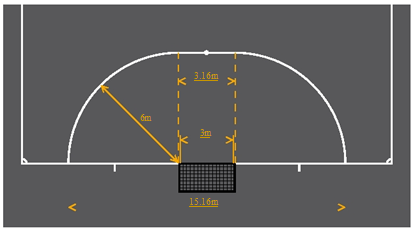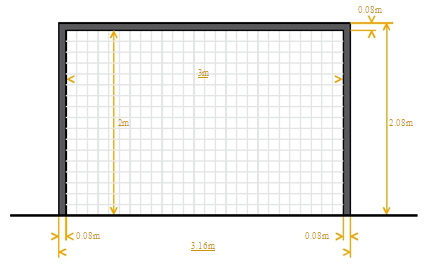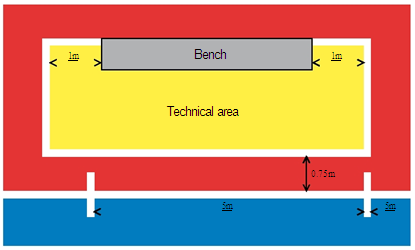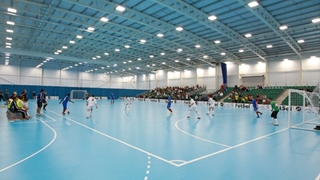
FIFA Futsal Laws of the Game
Pitch surface
Matches should be played on flat, smooth and non-abrasive surfaces, preferably made of wood or artificial material, according to the rules of the competition. Concrete or tarmac should be avoided. Artificial turf pitches are permitted in exceptional cases and only for national competitions.
Pitchmarkings
The pitch must be rectangular and marked with lines. These lines belong to the areas of which they are boundaries and must be clearly distinguishable from the colour of the pitch. The two longer boundary lines are called touch lines. The two shorter lines are called goal lines.
The pitch is divided into two halves by a halfway line, which joins the midpoints of the two touch lines.
The centre mark is indicated at the midpoint of the halfway line. A circle with a radius of 3 m is marked around it. A mark must be drawn outside the pitch, 5 m from the corner arc and at right angles to the goal line, to ensure that defending players retreat this distance when a corner kick is being taken. The width of this mark is 8 cm.
Two additional marks, each at a distance of 5 m to the left and the right of the second penalty mark, must be made on the pitch to indicate the minimum distance to be retreated when a kick is being taken from the second penalty mark. The width of this mark is 8 cm.
Dimensions
The length of the touch line must be greater than the length of the goal line.
All lines must be 8 cm wide.
For non-international matches the dimensions are as follows:
Length (touch line):
-
minimum 25 m
-
maximum 42 m
Width (goal line):
-
minimum 16 m
-
maximum 25 m
For international matches the dimensions are as follows:
Length (touch line):
-
minimum 38 m
-
maximum 42 m
Width (goal line):
-
minimum 20 m
-
maximum 25 m
The Penalty area
Two imaginary lines of 6 m in length are drawn from the outside of each goalpost and at right angles to the goal line; at the end of these lines a quarter circle is drawn in the direction of the nearest touch line, each with a radius of 6 m from the outside of the goalpost. The upper part of each quarter circle is joined by a line 3.16 m in length running parallel to the goal line between the goalposts. The area bounded by these lines and the goal line is the penalty area.
Within each penalty area, a penalty mark is made 6 m from the midpoint between the goalposts and equidistant to them.
The Second penalty mark
A second mark is made 10 m from the midpoint between the goalposts and equidistant to them.
The Corner Arc
A quarter circle with a radius of 25 cm from each corner is drawn inside the pitch.
Goals
A goal must be placed on the centre of each goal line.
A goal consists of two upright posts equidistant from the corners and joined at the top by a horizontal crossbar. The goalposts and crossbar must be made of wood, metal or other approved material. They must be square, rectangular, round or elliptical in shape and must not be dangerous to players.
The distance (inside measurement) between the posts is 3 m and the distance from the lower edge of the crossbar to the ground is 2 m.
Both goalposts and the crossbar have the same width and depth, 8 cm. The nets must be made of hemp, jute or nylon or other approved material and are attached to the back of the goalposts and the crossbar with a suitable means of support. They must be properly supported and must not interfere with the goalkeeper.
The goalposts and crossbars must be of a different colour from the pitch.
The goals must have a stabilising system that prevents them from overturning.
Portable goals may only be used if they satisfy this requirement.
The substitution zones
The substitution zones are the areas on the touch line in front of the team benches, the purpose of which is described in Law 3.
- They are situated in front of the technical area and are 5 m in length. They are marked at each end with a line 80 cm in length, 40 cm of which is drawn on the pitch and 40 cm off the pitch, and 8 cm wide
- The area in front of the timekeeper's table 5 m to either side of the halfway line is kept clear
- A team's substitution zone is situated in the half of the pitch defended by said team and changes in the second half of the match and periods of extra time, if any
Pitch
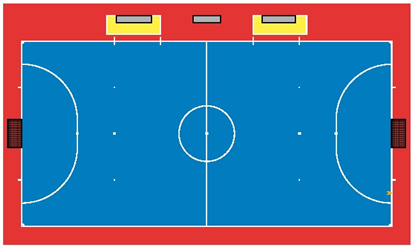
Pitch dimensions
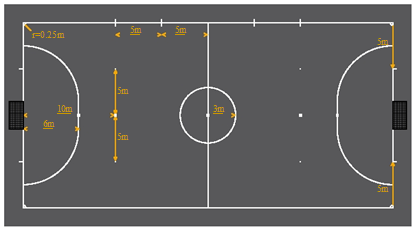
Penalty area
Goal
Substitution zone and technical area
Decision 1
The technical area must meet the requirements contained in the section entitled "The Technical Area".


